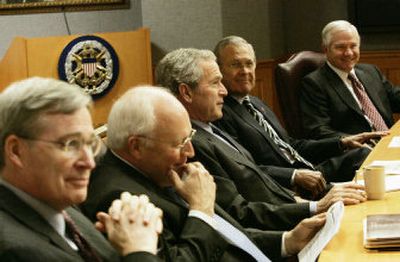Joint chiefs push new Iraq mission

WASHINGTON – The nation’s top uniformed leaders are recommending that the United States change its main military mission in Iraq from combating insurgents to supporting Iraqi troops and hunting terrorists, said sources familiar with the White House’s ongoing Iraq policy review.
President Bush and Vice President Dick Cheney met with the members of the Joint Chiefs of Staff on Wednesday at the Pentagon for more than an hour, with the president engaging his top military advisers on different options. The chiefs made no dramatic proposals but, at a time of intensifying national debate about how to solve the Iraq crisis, offered a pragmatic assessment of what can and cannot be done by the military, the sources said.
The chiefs do not favor adding significant numbers of troops to Iraq, said sources familiar with their thinking, but see strengthening the Iraqi army as pivotal to achieving some degree of stability. They also are pressing for a much greater U.S. effort on economic reconstruction and political reconciliation.
Sources said Gen. George Casey, the top U.S. commander in Iraq, is reviewing a plan to redefine the American military mission there: U.S. troops would be pulled out of Iraqi cities and consolidated at a handful of U.S. bases while day-to-day combat duty would be turned over to the Iraqi army. Casey is still considering whether to request more troops, possibly as part of an expanded training mission to help strengthen the Iraqi army.
The recommendations Casey is reviewing to overhaul the military mission were formulated by Lt. Gen. Peter Chiarelli, the outgoing top U.S. ground commander, officials said. The plan positions the U.S. military to be able to move swiftly to a new focus on training, one of the key recommendations from several reviews of U.S. strategy, including from the bipartisan Iraq Study Group.
Under the plan developed by Chiarelli’s staff, the military would shift about half of its 15 combat brigades away from battling insurgents and sectarian violence and into training Iraqi security forces as soon as the spring of 2007, military and defense officials said. In northern and western Iraq, U.S. commanders are already moving troops out of combat missions to place them as advisers with lower-level Iraqi army units, Maj. Gen. William Caldwell, spokesman for the military in Iraq, said Wednesday at a briefing in Baghdad.
Administration officials stressed that Bush, under pressure from Congress and the electorate to abandon the United States’ open-ended commitment, has made no final decisions on how to proceed in Iraq. But the new disclosures suggest that military planning is well under way for a major change from an approach that has assigned the bulk of responsibility for security in Iraq to more than 140,000 U.S. troops.
The chiefs also want to see a new push on political and economic issues, especially employment programs, reconstruction and political reconciliation, to help quell the problems that have fueled both the Sunni insurgency and Shiite-Sunni sectarian strife, say defense officials and U.S. military officers in Iraq. A new jobs program is considered key to pulling young men from the burgeoning militias.